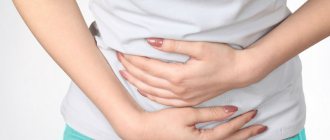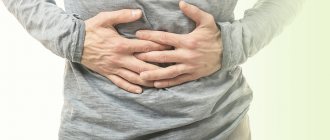Esophagoscopy is an endoscopic examination of the esophagus for the purpose of diagnosing esophagitis and other pathologies of the esophagus. This procedure belongs to a series of instrumental studies and is performed with an endoscope, which is inserted through the mouth into the patient’s pharynx.
This technique allows specialists to conduct a visual examination of the mucous membrane of the inner wall of the esophagus and timely diagnose various pathologies.
Advantages and disadvantages
Unlike other studies, esophagoscopy allows appropriate therapy to be carried out during diagnosis, namely, to remove the foreign body and stop bleeding, as well as take biopsy material for histological examination.
Esophagoscopy, compared to similar diagnostic procedures, is one of the most informative and safe, and is gaining popularity every day. Today, this procedure is carried out in clinics and outpatient clinics.
Content:
- Advantages and disadvantages
- Who performs esophagoscopy?
- When is esophagoscopy prescribed?
- How to prepare for esophagoscopy?
- Diagnostic process
Like all endoscopic examinations, esophagoscopy has a number of contraindications. Research is not recommended in the acute period (first week) after a chemical burn; for acute infectious diseases; for acute processes in the digestive system and intestinal obstruction; severe cardiac and vascular pathologies; psychiatric diseases; traumatic brain injuries.
The diagnostic process can be difficult in patients with a curved spine and excess weight.
After esophagoscopy, the development of complications is possible. Among the threatening complications, in rare cases, it is possible to perforate the wall of the esophagus, bleeding as a result of trauma from varicose veins of the esophagus, or from neoplasms of the esophagus. It is possible to develop an anaphylactoid reaction to the anesthetic used to treat the oropharynx before inserting the endoscope.
Indications for the procedure
All of these diseases are more treatable if detected early. You can check the condition of the digestive organs at the Yusupov Hospital. Our doctors delicately and accurately perform endoscopic examination of the upper gastrointestinal tract - esophagogastroduadenoscopy (EGD).
This research method is prescribed for suspected pathology of the esophagus, stomach, and duodenum. Endoscopy allows you to perform a detailed examination, assess the condition of the mucous membrane of the examined organs and identify minimal changes that cannot be detected with other methods.
In particular, endoscopy is indispensable in the diagnosis of all types of gastritis, erosions, peptic ulcers, reflux esophagitis, Barrett's esophagus, as well as benign formations - adenomas, hyperplastic polyps, papillomas and malignant tumors, including in the early stages.
The reason for performing esophagogastroduadenoscopy may be patient complaints such as:
- heartburn,
- discomfort, abdominal pain,
- nausea, vomiting,
- feeling of a "lump in the throat"
- difficulty eating.
This study is also recommended for asymptomatic patients who have relatives with gastrointestinal cancer.
When is esophagoscopy prescribed?
Instrumental examination of the esophagus using an esophagoscope is carried out in two cases: for diagnosing pathological processes and for treatment.
So, using esophagoscopy, a specialist diagnoses:
- abnormal development of the esophagus and its walls;
- achalasia cardia (narrowing of the lower esophageal sphincter);
- erosive and ulcerative damage to the mucous membrane;
- diverticulum and tumor processes;
- reflux disease;
- the presence of foreign bodies and scar strictures (as a result of a chemical burn).
During diagnosis, material may be taken for further histological examination - a small piece of tissue from the esophageal mucosa is separated and sent for histological examination. Thus, if you suspect the presence of a neoplasm on the walls of the esophagus, it is possible to confirm or refute the assumption using a biopsy.
Endoscopy is also recommended for the following purposes:
- remove foreign tumor;
- use sclerosing agents to treat varicose veins in the walls of the esophagus to reduce the risk of bleeding;
- stop the bleeding (in this case, electrocoagulation is used or clips are applied to the bleeding vessels);
- bougienage of the esophagus.
Often, esophagoscopy is performed under anesthesia in the following situations, when the patient was diagnosed with: a large foreign body; suspicion that a foreign body is wedged into the walls of the esophagus; disturbance of the patient's auditory and speech reactions; mental system disorder; pathological processes affecting the cardiovascular system.
Under anesthesia, esophagoscopy is performed for children.
Part I. GERD. Methods for studying the functions of the esophagus
Part I. Gastroesophageal reflux disease (continued)
V.F.
Privorotsky, N.E. Luppova Methods for studying the functions of the esophagus
X-ray diagnostics
Typically, a barium examination of the esophagus and stomach is performed in direct and lateral projections and in the Trendelenburg position with slight compression of the abdominal cavity. The study evaluates the permeability of the suspension, the diameter of the esophagus, contours, elasticity of the walls, pathological narrowings, ampulla-shaped expansions, peristalsis, and relief of the mucosa. With obvious reflux, the esophagus and stomach radiographically form the figure of an “elephant with a raised trunk”, and on delayed radiographs a contrast agent appears in the esophagus again, which confirms the fact of reflux. The method is of great importance in the diagnosis of herpes hiatus, anomalies of the esophagus, assessment of the consequences of injuries and surgical interventions, and is indispensable in the diagnosis of functional diseases of the esophagus.
Endoscopic examination
The method is inferior to the x-ray method in assessing the motor function of the esophagus and cardia, but is superior to the latter in assessing the microrelief of the mucous membrane, identifying inflammatory changes, erosions, ulcers, etc. Currently, flexible fibroesophagogastroduodenoscopes of small diameter (6.0-9.0 mm) are used in pediatrics. with end optics from Japanese, Pentax, Fujinon, devices (Germany) and some others. Fibroesophagogastroduodenoscopy (FEGDS) allows you to confidently diagnose a number of congenital anomalies of the esophagus (atresia, stenosis, “short esophagus”, etc.), acquired diseases of inflammatory and non-inflammatory origin. The method is also indispensable in the diagnosis of tumor diseases of the esophagus, foreign bodies, and in monitoring the condition of the esophagus after surgical interventions. When performing FEGDS, the condition of the LES is specifically examined: the degree of closure of the cardia, the height of the Z-line, and indirect signs of the herpes hernia are assessed. An adequate assessment of the condition of the mucous membrane of the esophagus, especially its abdominal section, is of great importance. You should pay attention to the severity of inflammation, the presence of foci of ectopia, polypoid formations, fissures, as well as the location, type and number of erosions and ulcers. When describing prolapse of the gastric mucosa into the esophagus, the endoscopist must indicate the height of the prolapse (in centimeters), its one-sidedness (along one wall) or its circularity, as well as the duration of fixation of the prolapse complex in the esophagus. When performing esophagoscopy in children, the endoscopist must be able to navigate a whole range of microsigns, which makes it possible to identify pathology or a predisposition to it in the early (often preclinical) stages. On the other hand, there is always a risk of overdiagnosis of various conditions. In particular, prolapse of the gastric mucosa into the esophagus, often endoscopically detected in children, is not always a reliable criterion for herpes hiatus. There is a special technique for reverse examination of the subcardial zone of the stomach during an endoscopic examination, which is not always feasible, especially in young children. Endoscopic diagnosis of herpes hiatus becomes more reliable if a combination of the following signs is detected: high (more than 3 cm) circular prolapse of the gastric mucosa into the esophagus, with partial fixation of the prolapse complex (up to 5 seconds or more). However, if prolapse is detected and if there is a suspicion of herpes hiatus, additional x-ray examination is necessary. If suspicious areas are identified during an endoscopic examination (for example, ectopic epithelium), chromoscopy is indicated (staining the mucous membrane with a 0.3% solution of Jungo red or a 0.1% solution of methylene blue).
Endoscopic classification of eeophagitis
Among the many well-known classifications of esophagitis, the most popular among gastroenterologists are the Savary-Miller (1978), SJNTutgat (1990, 1996), Los Angeles (1994) and Yu.A. classification.
Vasilyeva (2000). Despite all the advantages of the mentioned classifications, they are not always suitable for assessing changes in the esophagus in children. In addition, they do not take into account the severity of motor disorders at the level of the esophagus, cardia and subcardial zone of the stomach. In our clinical practice, we use a version of G. Tutgat’s (1990) classification modified to take into account children’s age. SYSTEM OF ENDOSCOPIC SIGNS OF GASTROESOPHAGEAL REFLUX IN CHILDREN
(according to G.Tutgat modified by V.F. Privorotsky et al.)
Morphological changes
0 degree
The mucous membrane of the esophagus is not changed.
I degree
Moderate focal erythema and (or) friability of the mucous membrane of the abdominal esophagus.
II degree
The same + total hyperemia of the abdominal esophagus with focal fibrinous plaque and the possible appearance of single superficial erosions, often linear, located at the tops of the folds of the mucous membrane.
III degree
The same + spread of inflammation to the thoracic esophagus.
Multiple (sometimes merging) erosions located in a circular pattern. Increased contact vulnerability of the mucous membrane is possible. IV degree
Esophageal ulcer. Barrett's syndrome. Esophageal stenosis.
Motor disturbances
A.
Moderately expressed motor disturbances in the area of the LES (raising of the Z-line up to 1 cm), short-term provoked subtotal (along one of the walls) prolapse to a height of 1-2 cm, decreased tone of the LES.
B.
Clear endoscopic signs of cardin insufficiency, total or subtotal provoked prolapse to a height of more than 3 cm with possible partial fixation in the esophagus. B. The same + pronounced spontaneous or provoked prolapse above the legs of the diaphragm with possible partial fixation Example of an endoscopic conclusion: “Reflux esophagitis degree II-B.” I would like to emphasize that esophageal ulcer, esophageal stenosis and Barrett's esophagus, under certain conditions, can be considered not only as manifestations of GER (GERD), but also as complications of the latter. The above classification does not pretend to be absolute, but at the same time it is an attempt to combine visual structural and motor characteristics.
Histological examination
A targeted biopsy of the esophageal mucosa in children with subsequent histological examination of the material is carried out for the following indications:
- in case of discrepancies between radiological and endoscopic data in unclear cases;
- with an atypical course of erosive-ulcerative esophagitis;
- if a metaplastic process in the esophagus is suspected (Barrett's transformation);
- with papillomatosis of the esophagus;
- if a malignant tumor of the esophagus is suspected.
In other cases, the need for a biopsy is determined individually.
It should be remembered that the anatomical zone of the esophagogastric junction does not coincide with that identified endoscopically. In this regard, for a reliable diagnosis of the condition of the esophagus, it is necessary to take at least two biopsies 2 or more centimeters proximal to the Z-line. The most common variants of the histological conclusion are different degrees of inflammation, inflammatory-dystrophic changes are less often determined, metaplastic changes are much less common and, incidentally, signs of malignant degeneration are rarely detected. Intraesophageal pH-metry
One of the most important methods that allows you to accurately detect the reflux of acidic stomach contents into the esophagus.
Using it, you can not only record the very fact of acidification of the esophagus, but also estimate its duration. Currently, acidogastrometers of various modifications are used (AGM 10-01, AGM 01, etc.), computer systems such as “ Gastroscan-5
” (for standard, 2-3-hour pH-metry), “
Gastroscan-24
” (for daily pH monitoring), “Gastrotest”, etc. The multifunctional computer system (Sweden) is considered one of the best in the world. When studying children, standard 2-, 3-, or 5-channel pH probes are used. One of the sensors is installed in the esophagus 5 cm above the cardia. The depth of probe insertion can be calculated using the Bischoff formula, modified by M.A. Kurshin and V.M. Muravyova (1987):
X= 0.2Y + 1.5 cm,
where X is the length of the probe in cm, Y is the child’s height. As is known, in healthy children the environment in the esophagus is neutral or slightly acidic (pH - 6.5-7.0), therefore any “acidification” of the esophagus detected by pH-metry can be regarded as reflux. However, as mentioned above, not every reflux is pathological. Signs of pathological GER (according to 3-hour pH-metry) are:
- a decrease in pH in the esophagus below 4.0 for 5 minutes or more;
- determination of at least 3 episodes of reflux within 5 minutes;
- restoration of pH in the esophagus for a period exceeding 5 minutes.
Only a combination of all three signs allows one to confidently diagnose pathological “acid” GER. It should be remembered that when performing routine intraesophageal pH-metry, a false negative result can be obtained in a number of cases. To increase the sensitivity of the method, special functional tests are used: changing the position of the patient’s body during the study, a test with physical activity (squats, bending, etc.). The “gold standard” in the diagnosis of pathological GER is daily pH monitoring, which allows not only to detect reflux, but also to determine the degree of its severity, as well as to determine the influence of various provoking factors on its occurrence and to select adequate therapy. The study is carried out with a special ultra-thin probe, which is inserted intranasally and does not make it difficult for the patient to eat, does not affect sleep and other physiological needs. When assessing the results obtained, internationally accepted normative indicators developed by TR DeMeester are used (Table 1).
Table 1. Normal 24-hour monitoring values (according to TR DeMeester, 1993)
How to prepare for esophagoscopy?
This method of instrumental research is carried out on an empty stomach. The last meal should be no less than 6 hours before the start of the study. Residues of food in the esophagus may negatively affect the test results.
Best materials of the month
- Coronaviruses: SARS-CoV-2 (COVID-19)
- Antibiotics for the prevention and treatment of COVID-19: how effective are they?
- The most common "office" diseases
- Does vodka kill coronavirus?
- How to stay alive on our roads?
Three days before esophagoscopy you should not drink alcohol, and the day before the study it is not recommended to smoke.
If the patient is taking medications, it is necessary to discuss this issue with the attending physician. The diagnosis may need to be rescheduled, since the action of the active components can significantly affect the results of instrumental diagnostics.
How is EGDS performed?
The procedure is performed under local anesthesia or under medicated sleep. The patient is placed on his side and an endoscope, a thin flexible probe equipped with a video camera, is inserted through the esophagus. The examination lasts 10-20 minutes, during which time the doctor determines the presence of a particular pathology and, if necessary, takes tissue samples for morphological examination and diagnosis of Helicobacter pylori infection.
Esophagogastroduadenoscopy at the Yusupov Hospital is performed by an experienced endoscopist Natalya Vidyayeva, who specializes in identifying pre-tumor pathology of the gastrointestinal tract, as well as tumors at an early stage. Our doctor completed an internship in Japan under the guidance of leading experts in the field of endoscopic diagnosis and treatment.
The Yusupov Hospital uses modern equipment that allows you to obtain high-definition endoscopic images with 80x magnification. Our doctors use additional technologies of narrow-spectrum endoscopy and chromoscopy, which allow us to visualize the pattern of blood vessels, evaluate the structure of the surface of the epithelium of internal organs and identify possible pathology at a very early stage.
What can fluoroscopy reveal?
Using radiography, a specialist can detect most diseases of the esophagus. In the results obtained, a number of signs indicate anomalies and pathologies.
Pathological changes in the diameter of the esophagus (narrowing/expansion)
Narrowing of the lumen of the esophagus can occur due to inflammation, injury, disease or tumor. In some cases, the symptom can lead to complete or partial obstruction and severe complications.
Dilatation of the esophagus is rare and, as a rule, develops with neuromuscular pathology (alachasia cardia), adhesions or neoplasms. The symptom develops when an obstruction appears in the lower esophagus, preventing food and liquids from reaching the stomach.
In both cases, diagnosing the causes of the pathology and developing the correct treatment strategy requires a detailed analysis of images obtained using intestinal radiography.
Local narrowing
Narrowing of the esophagus can occur due to visceral-visceral or cortico-visceral disorders. X-ray examination allows you to localize the narrowing of the esophagus, determine its extent and the degree of reduction in the lumen.
Protrusion of the esophageal wall outward with a decrease in the internal lumen
Protrusions of the wall of the esophagus in the form of a bag (diverticula) account for almost half of all diverticula of the gastrointestinal tract. Pathology occurs due to local muscle weakness. With diverticulum, the patient complains of soreness, a feeling of a lump, bad breath and other symptoms. To diagnose pathology, radiography of the esophagus, esophagoscopy and other procedures are prescribed.
Violation of the integrity of the walls - erosion, ulcers
Peptic ulcer disease of various parts of the gastrointestinal tract occurs in almost a quarter of the world's population. On the mucous membrane of the esophagus, ulcers can form due to exposure to gastric juice, reflux (true or peptic ulcers) or malignant tumors or other diseases (symptomatic ulcers).
To localize the pathology and determine its cause, an X-ray of the esophagus with contrast is prescribed.
Brief description of the procedure
X-ray of the esophagus is not associated with invasion and is therefore considered a safe examination method. During the diagnosis, the specialist takes a series of x-rays of the esophagus. A barium-based contrast agent is often used to obtain a clearer, more detailed image and to view the area of interest during operation.
In most cases, an x-ray of the esophagus is performed, because the method shows the condition of the organ in real time and allows you to assess its volume and shape, and see the esophagus in action.
What is the method, what is the essence
The basis of the method is the ability of X-rays to penetrate tissue with different intensities. When contrasting, the injected substance delays the x-ray beam, allowing you to obtain accurate data on the structure of the esophagus and stomach, allowing you to find anatomical defects and dysfunction of the walls if the study is carried out over time. To obtain clear images, the patient takes a special position so that the contrast evenly covers the mucous membranes of the esophagus. The contrast agent film completely follows the contours of the organ and is clearly visible on photographs in any projection.





